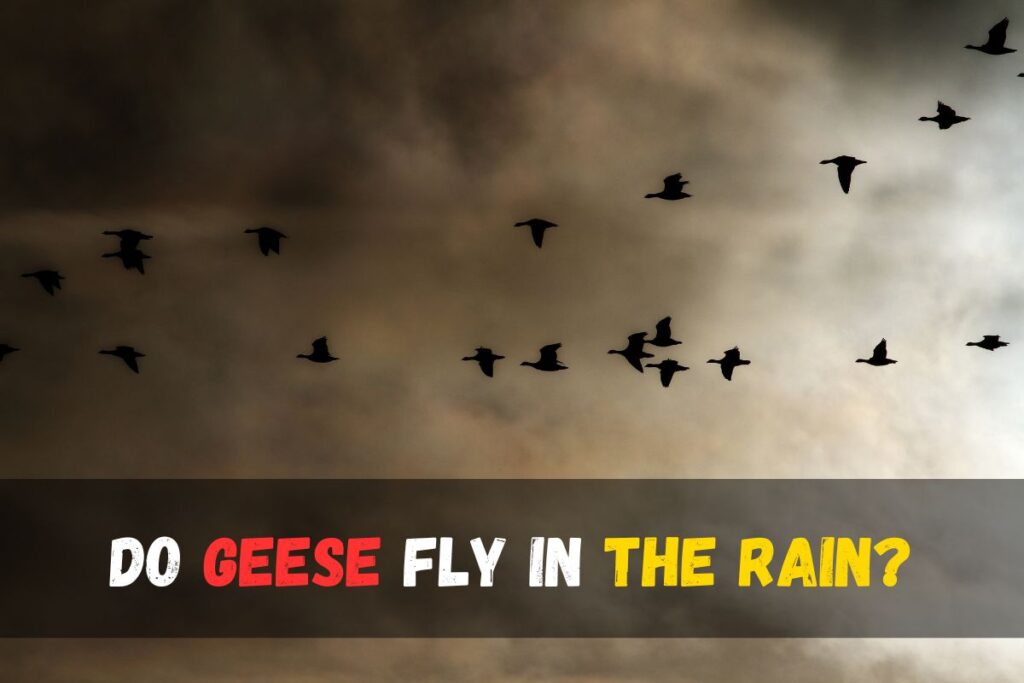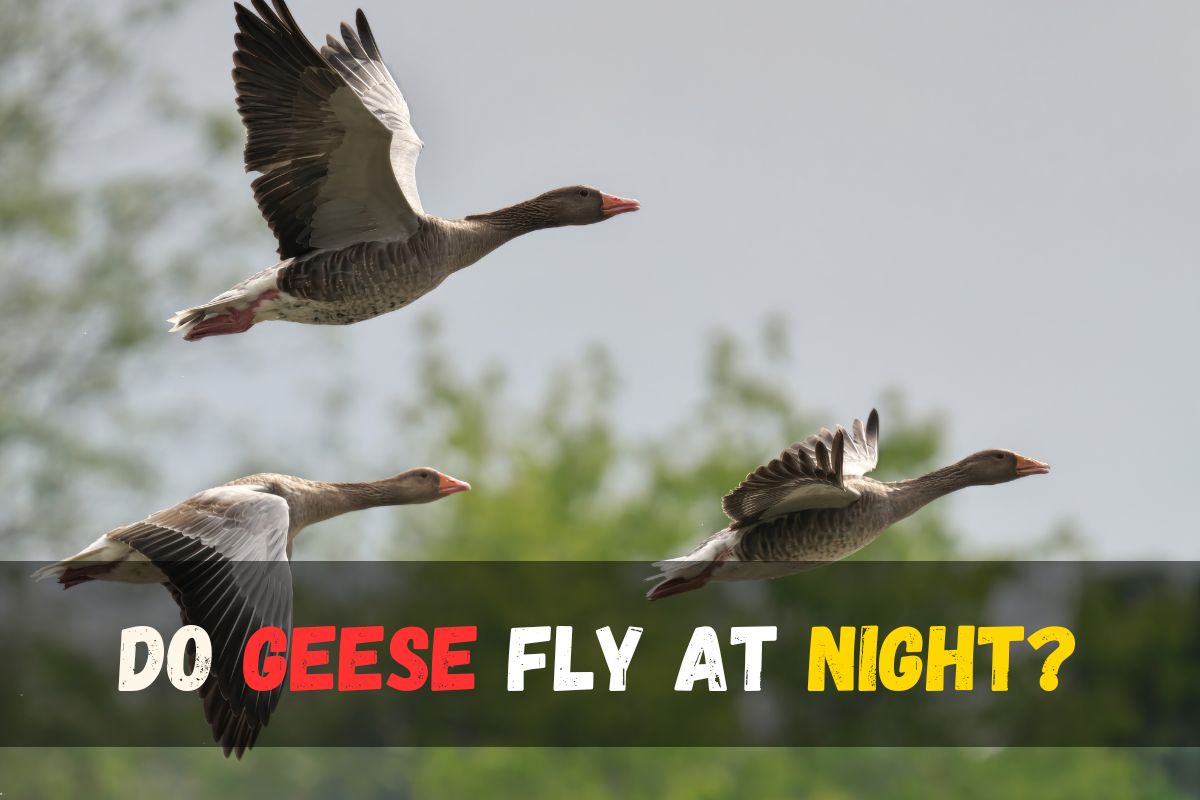Do geese fly at night?
The question of whether geese fly at night has piqued the curiosity of many, and the answer is that Yes, geese do fly at night. Geese, often associated with their avian counterparts, are remarkable creatures known for their nocturnal lifestyle. They take to the skies at night, a phenomenon observed in the autumn and winter seasons. These birds exhibit extraordinary skills as they navigate through the dark overhead in V-formations, honking as they go. This behavior is a key element of their migratory routine, one that has been the subject of many stories and admiration.
Unlike humans, geese have evolved to thrive in low light conditions, making them well-adapted to navigating the night sky. This specialized night vision is essential for their survival during their long migratory journeys. Their stories of nocturnal flights have fascinated many, often taking them across vast distances.
In the fascinating world of avian species, the behavior and habits of animals, including birds, are influenced by a variety of factors, such as whether they are diurnal or nocturnal. When it comes to geese, these waterfowls, like many other birds, are primarily diurnal creatures. They are known for their majestic formations and migratory flights during the day. Geese often venture out to forage and socialize under the warmth of the sun, which aligns with their daytime lifestyle.
The concept of nocturnal behavior is more commonly associated with owls and nightjars among the avian species. These birds are emblematic of the night, as they prefer to fly and hunt during the darker hours. Their adherence to the night is a well-documented phenomenon in the world of ornithology.
Can Geese and Ducks Mate?
Why Do Geese Fly at Night
Canada Geese prefer to fly at night for several compelling reasons.
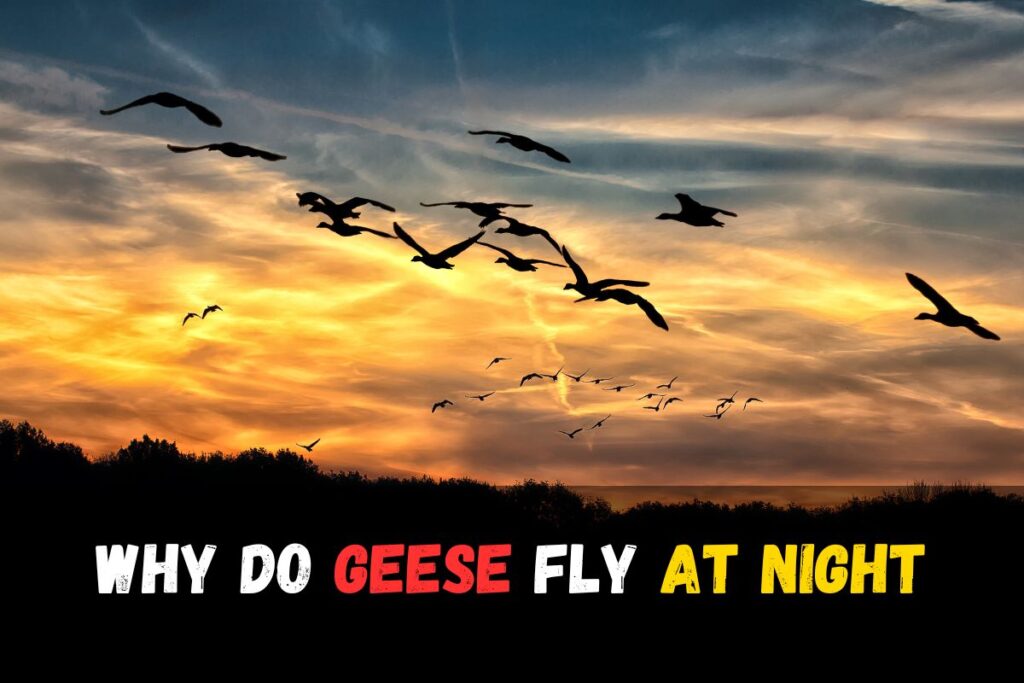
Minimizing Predation Risk
Despite their large size and remarkable flight skills, Canada Geese are not invulnerable. Their substantial size makes them a prime target for predatory birds such as falcons, hawks, and eagles.
Moreover, their long-distance journeys are physically exhausting, leaving them weaker than usual. This diminished strength makes them less capable of defending themselves against their predators. So, flying at night helps Canada Geese minimize the risk of being targeted and ensures a safer journey during their migration south.
Highlighting the Diurnal Nature of Many Predators
To minimize predation risk, many predators, such as birds of prey and other animals, are primarily active during the daytime, capitalizing on clear visibility and the advantage of daylight for hunting and locating their prey. Geese, understanding this diurnal nature of many predators, have adjusted their migration patterns strategically. They opt to fly at night to reduce their exposure to potential threats from these diurnal predators, thus enhancing their chances of survival.
Avoid Potential Threats During Daylight Hours
Minimizing predation risk is a crucial survival strategy for migrating geese. To achieve this, geese avoid daylight hours when visibility is higher, and the risk of being detected or targeted by predators is elevated. By flying at night and taking advantage of the cover of darkness, geese reduce the likelihood of being spotted by diurnal predators that rely on visual cues for hunting. This strategic adaptation decreases the chances of ambush or attacks, particularly during the critical migration period, enhancing the geese’s chances of a safe and successful migration.
Canada Geese opt to fly at night
Canada Geese opt to fly at night due to Calmer Air and Energy Conservation Nighttime conditions offer more stable and less turbulent air, reducing the physical demands of their long-distance journey. This calmer air minimizes the risk of being tossed about by strong winds, making nighttime flights more efficient
How Calmer Air at Night Reduces Energy Expenditure?
Calmer air at night reduces energy expenditure for flying creatures, like birds, due to the environmental conditions that prevail during nighttime. During the night, the atmosphere tends to be more stable and less turbulent than during the day. This reduced turbulence means that there are fewer irregular air movements and wind currents that birds need to contend with. As a result, birds, such as Canada Geese, can fly in a more streamlined and energy-efficient manner. They require less energy to maintain their flight path and navigate through the sky. Essentially, the stillness of the night air provides a smoother and less physically demanding flying experience, enabling these birds to conserve valuable energy during their nocturnal journeys.
The function of thermal updrafts and turbulence during daylight hours.
During the day, thermal updrafts and turbulence play significant roles in the flight of birds and aircraft. Thermal updrafts, which are rising columns of warm air generated by sunlight warming the Earth’s surface, can provide lift and altitude to birds and gliders. Birds can take advantage of these rising currents to gain altitude and reduce the energy required for flying. However, turbulence, often caused by wind variations, temperature gradients, and atmospheric instability, can be a challenge. Turbulence disrupts the smooth flow of air, making flight less stable and more physically demanding for birds and aircraft. Pilots and birds have to work harder to maintain their course and altitude in turbulent conditions, which can lead to increased energy expenditure and the need for more precise navigation. The interplay between thermal updrafts and turbulence during the day significantly affects the efficiency and effort required for flying.
Energy Conservation During Long-distance Flights
Energy conservation during long-distance flights is a critical concern for geese. These birds must cover thousands of kilometers, often facing inhospitable terrains and adverse weather conditions. To optimize their energy usage and ensure the successful completion of their journey, geese employ a clever strategy. They choose to fly at night when the air is calmer, allowing them to minimize the energy expended on flight control and stabilization. This approach enables them to efficiently allocate their resources, ensuring they have enough energy for essential activities such as foraging and resting during stopovers along their migration route. By taking advantage of the calmer nighttime air conditions, geese significantly reduce the energy expenditure required for flight control and stabilization, ultimately improving their chances of survival during these demanding long-distance migrations.
Moonlight Navigation
Moonlight Navigation plays a significant role in the nighttime venture of Geese. To learn more about this matter, you can check out the following section.

The capacity of geese to navigate by utilizing the moon and stars.
Geese, through their remarkable instinct for celestial navigation, exhibit a unique ability to utilize the positions of celestial objects like the moon and stars. This skill allows them to orient themselves during their flights, even in the absence of daylight. By referencing the night sky, geese can determine their general direction and maintain a course aligned with their intended migration route. This celestial navigation capability is not learned but is believed to be an innate skill passed down through generations of migratory geese. In essence, geese can navigate using the moon and stars as their guides, a fascinating aspect of their migratory behavior.
Cooler Temperatures and Flight Performance
Cooler temperatures play a significant role in enhancing the flight performance of geese. During their demanding migratory flights, geese generate metabolic heat, and the risk of overheating can be detrimental. However, cooler nighttime temperatures help reduce the temperature differential between the environment and their bodies. This allows geese to maintain a more comfortable body temperature and regulate their metabolic processes more efficiently. Consequently, the cooler temperatures contribute to improved thermoregulation and reduced heat stress, ultimately optimizing their flight performance.
Daytime Flight Strategies
Daytime Flight Strategies for Geese involve various crucial points that deserve attention. These strategies are essential for their safe and efficient flight during the day. To learn more about these strategies, check them out in the following phase.
Geese Also Fly During the Day in Certain Conditions
Geese are not limited to flying exclusively at night during migration. In certain situations, they engage in daytime flights. This behavior is particularly evident when favorable conditions arise that can aid their journey. Geese are adaptable in their flight patterns, adjusting based on various factors such as weather, wind patterns, and the availability of resources. This flexibility allows them to optimize their flights, increasing their chances of reaching their destination successfully.
| Flight Strategy | Description |
| Nocturnal Migration | Flying at night to avoid opposing winds, reducing resistance and conserving energy during migration. |
| Daytime Flights | Engaging in daytime flights under favorable conditions to benefit from tailwinds and updrafts for more efficient travel. |
| Weather-Based Changes | Adapting flight patterns based on weather, avoiding unfavorable conditions like storms or turbulence for safer journeys. |
| Wind Pattern Utilization | Adjusting routes to capitalize on tailwinds, enhancing flight efficiency and conserving energy. |
| Resource-Seeking Flights | Modifying flight plans to find essential resources like food and water during migration. |
| Flexible Flight Planning | Adjusting routes to capitalize on tailwinds, enhancing flight efficiency, and conserving energy. |
FAQ’s
Do Geese Fly At Dusk?
Yes, Geese are an exception to the usual behavior of birds. While most birds sleep during the day, Geese are still active at dusk. They fly in the second half of the day, as the light begins to fade away after sunset. This is because they don’t sleep during migration, and they are known to be active during dusk time.
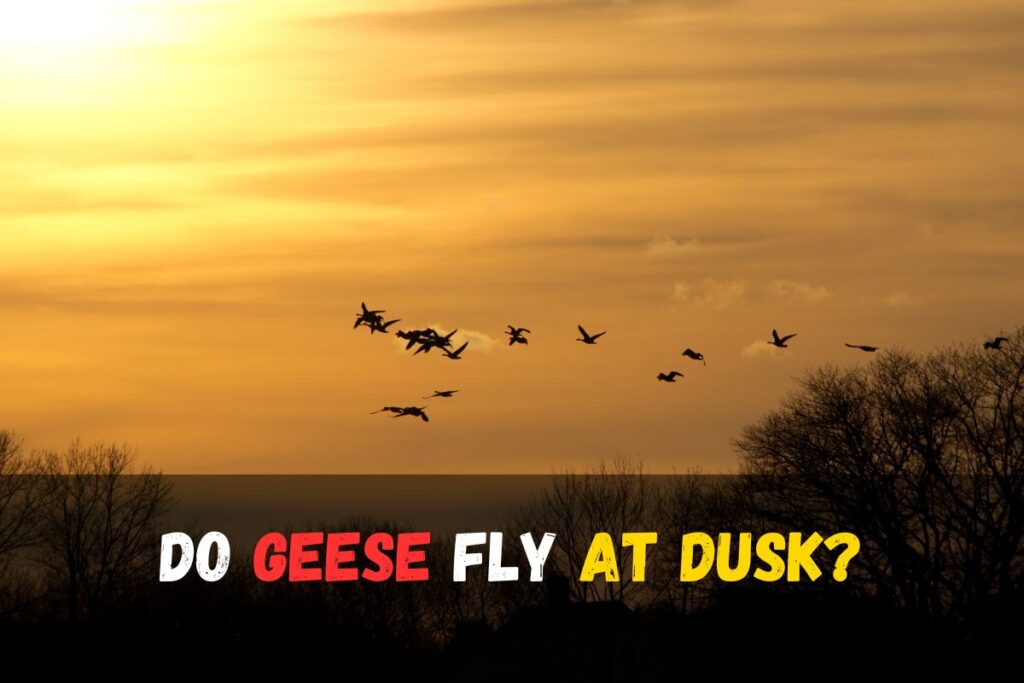
How do geese determine when it’s time to embark on their migration?
Geese, specifically Canada Geese, rely on various indicators to determine when it’s time to embark on their migration journey. One key factor is the freezing of water, particularly in their breeding areas. They tend to stay in their breeding grounds until the water starts to freeze, which generally occurs in autumn. This freezing of water serves as a crucial signal for them to begin their migration.
The Canada Geese that migrate usually start their journey between September and November. Those who depart in September tend to take fewer rest breaks along their way and make a concerted effort to reach their destination as quickly as possible. In contrast, geese that start their migration later in the season take longer breaks at resting spots, allowing them to travel more comfortably. So, the freezing of water and the changing seasons play a significant role in signaling to Canada Geese that it’s time to migrate.
The Mystery Behind Geese’s V-Formation In Flight
The V-formation observed in the flight of Canada Geese during their migration has fascinated many bird enthusiasts. There are two key reasons behind this intriguing behavior. Firstly, Canadian geese are inherently social birds and migrate in large flocks. The V-formation makes it easier for them to maintain visual contact with every goose in the group, facilitating communication and coordination. Interestingly, this formation is not exclusive to geese; even fighter pilots utilize it for the same reasons.
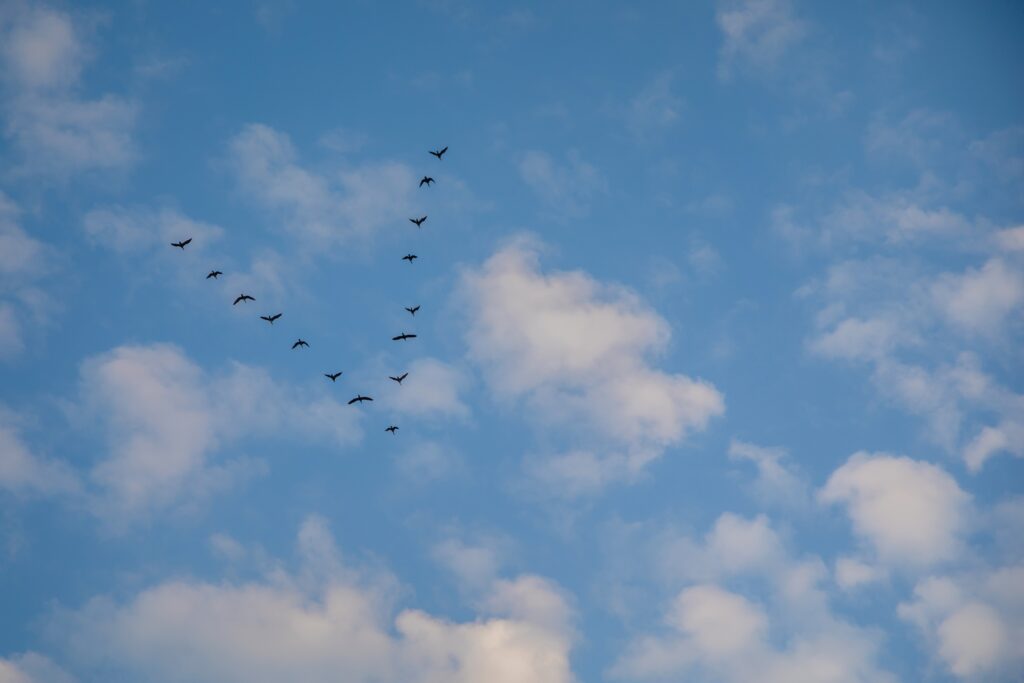
Secondly, the V-formation also serves the purpose of energy conservation. While it might not be obvious from the ground, the geese in this formation do not fly at the same altitude. The lead bird in the center flies at the lowest height, and each successive bird behind it flies slightly higher. This arrangement minimizes air resistance and enables the geese to conserve energy during their long migrations. So, the mystery behind the geese’s V-formation in flight is a combination of social behavior and energy-efficient flying techniques.
How long can a geese fly?
A Canada goose can fly up to 1,500 miles in a day, given suitable weather conditions. These birds typically maintain a flying speed of around 40 miles per hour during migration, but this speed can increase to as much as 70 miles per hour if they catch a strong tailwind. When migrating, Canada geese often travel in groups, with a range of 30 to 100 birds. So, the distance they can fly largely depends on factors like weather and the presence of tailwinds.
Why do geese honk while flying?
Geese honk while flying for several important reasons. First, their honking sounds help them take off in unison, ensuring a coordinated and synchronized liftoff. These vocal cues also aid in navigation, allowing the geese to stay together and maintain their formation during flight.
Additionally, honking serves as a means for geese to conserve energy while in the air. By flying in a V-shaped formation, the lead goose faces the most air resistance, and the honking of the geese behind provides moral support for the leader. The energy saved by flying in formation can be significant during long migrations.
Furthermore, each bird in the flock uses distinct honking patterns, which help them coordinate their movements during flight. This communication allows geese to adjust their positions, maintain the group’s cohesion, and respond to changes in flight conditions.
Do geese fly in the rain?
Geese may fly in the rain, but their flight patterns and behavior can be influenced by various factors, including the timing of the rain and the presence of other weather-related conditions. Geese are more likely to fly during breaks in the rain, spend most of the day feeding, and may also adjust their behavior based on major weather shifts associated with precipitation, such as plummeting barometric pressure, incoming cold fronts, or significant changes in wind direction. Therefore, while geese may fly in the rain, their behavior is influenced by the specific weather conditions and circumstances.
